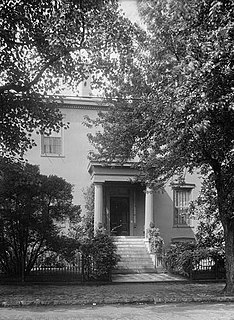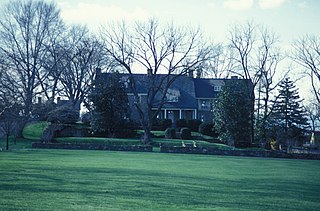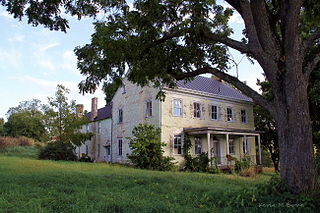
Upperville is a small unincorporated town in Fauquier County, Virginia, United States, along U.S. Route 50 fifty miles from downtown Washington, D.C.. Founded in the 1790s along Pantherskin Creek, it was originally named Carrstown by first settler Josephus Carr. Through an 1819 Act passed by the Virginia General Assembly, the name was changed to Upperville.

Middleburg Plantation is a historic colonial-era plantation on the Cooper River near Huger, South Carolina. The plantation house, built in 1699 by the French Huguenot Benjamin Simons in 1699, is probably the oldest standing wood-frame building in South Carolina, and is consequently an architecturally important example of period construction. It was declared a National Historic Landmark in 1970.

The Ellen Glasgow House, also known as the Branch-Glasgow House, is a historic house at 1 West Main Street in Richmond, Virginia. Built in 1841, it is nationally significant as the home of writer Ellen Glasgow (1873-1945) from 1887 until her death. It was declared a National Historic Landmark in 1971.

The Gen. William Mitchell House, also known as Boxwood or the Gen. Billy Mitchell House was the country estate and home of General Billy Mitchell (1879–1936) during the last ten years of his life, from 1926 through 1936. Mitchell was an American general who is regarded as the father of the U.S. Air Force. He is regarded as one of the most famous and most controversial figures in American airpower history. The house was declared a National Historic Landmark in 1976. It is located about .5 mile south of Middleburg on Virginia Route 626, straddling the county lines of Fauquier and Loudoun Counties. Part of the estate is now home to Boxwood Estate Winery.

Woodburn is a farm complex that was built beginning about 1777 for the Nixson family near Leesburg, Virginia. The first structure on the property was a stone gristmill, built by George Nixson, followed by a stone miller's residence in 1787, along with a stable. The large brick house was built between 1825 and 1850 by George Nixson's son or grandson George. The house became known as "Dr. Nixson's Folly." A large brick bank barn dates from this time, when Woodburn had become a plantation.

Benton, also known as Spring Hill, is a house in Loudoun County, Virginia, near Middleburg. The house was built by William Benton, a brickmaker and builder, around 1831. Benton had made a journey to Wales to collect an inheritance shortly after 1822 and there saw a house that he admired and wished to replicate on his own lands. He called the house "Spring Hill."

Grassdale is an Italianate-style villa in Louisa County, Virginia, notable for its size and style in a stable, rural region. The house was built in 1861 by James Maury Morris, Jr., a member of the prominent Morris family of Louisa County. The tract had originally been assembled by James Morris' grandfather, Colonel Richard Morris, who had established the neighboring Green Springs plantation. The property is part of the Green Springs National Historic Landmark District, established to preserve the notable houses of the area and their surrounding landscapes.

Intervale is a historic home located at Swoope, Augusta County, Virginia. The house was built about 1819, and remodeled and enlarged in the 1880s. It is a two-story, five bay brick I-house plan dwelling in the Colonial Revival style. It has an original one-story brick ell. The interior woodwork reflects German folk art design. Also on the property are the contributing log bank barn and a two-level spring house.

Mount Pleasant is a historic home and farm and national historic district located near Staunton, Augusta County, Virginia. The house was built about 1780–1810, and is a two-story, hall-parlor plan limestone structure with a rear ell dating to the mid-19th century. It is reflective of architecture of the Federal era. It has an original one-story brick ell. Also on the property are a contributing barn, corncrib, garage, storage shed, chicken house, the spring house, and an equipment shed. The property also include the ruins of a mill.

Annandale, also known as Alpine Farms, is a historic home located at Gilmore Mills, Botetourt County, Virginia. It was built in 1835, and is a two-story, Greek Revival-style brick dwelling with a deck-on-hip roof. It has a one-story, three bay, wooden front porch with tapering square columns. A two-story brick west wing and a single story frame ell, were added in 1969. Also on the property is a contributing brick dairy or meathouse.

Glebe of Westover Parish is a historic home located near Ruthville, Charles City County, Virginia. It built about 1745, as a 1 1/2-story, five-bay brick building, with an early 19th-century rear ell. It reflects Colonial and Federal style design elements. It also has an early 20th-century, one-story, frame wing. It was built as a glebe house for Westover Parish. The house was sold into private hands after the 1807 act of the General Assembly requiring the sale of all Virginia glebes.

Waverly, also known as Waverley, is a historic house located near Middleburg, Fauquier County, Virginia. The original section was built about 1790, and later enlarged about 1830, and enlarged and remodeled in the 1850s. It is a single-pile, center-hall, two-story dwelling, a typical example of an I-house. It has a long, two-story rear ell and has Gothic Revival style decorative detailing. The front facade features a full-width two-story portico with six square piers supporting a flat roof with a plain wooden parapet. The house was renovated after 1940 by architect David Adler.

Bleak Hill is a historic plantation house and farm located close to the headwaters of the Pigg River near Callaway, Franklin County, Virginia. Replacing a house that burned in January 1830, it was built between 1856 and 1857 by Peter Saunders, Junior, who lived there until his death in 1905. Later the house, outbuildings, and adjoining land were sold to the Lee family. The main house is the two-story, three bay, double pile, asymmetrical brick dwelling in the Italianate style. It measures approximately 40 feet by 42 feet and has a projecting two-story ell. Also on the property are a contributing two rows of frame, brick, and log outbuildings built about 1820: a two-story brick law office, a brick summer kitchen, a frame single dwelling, and a log smokehouse. Also on the property are two contributing pole barns built about 1930.

Willow Shade, also known as the Willa Cather House, is a historic home located near Winchester, Frederick County, Virginia. The house was built in 1851, and is a two-story, five-bay-by-three-bay, rectangular brick dwelling in a vernacular Late Greek Revival style. It has a three bay by two bay rear ell. The house sits on an English basement. It was the childhood home of author Willa Cather (1873–1947) and was built by her grandfather, William Cather. She was born at the nearby Willa Cather Birthplace and resided at Willow Shade from 1874 to 1883 before moving to Nebraska.

Bolling Island is a historic plantation house located overlooking the upper James River near Goochland, Goochland County, Virginia. The original frame section, now the east wing, was built in 1771. The principal two-story, hipped roof brick core was built between 1800 and 1810.

John Beaver House, also known as the Thomas Shirley House, is a historic home located near Salem, Page County, Virginia. It was built in 1825-1826, and is a two-story, four bay, single pile brick dwelling. It has two entryways, a three-course molded brick cornice under the eaves of the gable roof, and exterior end chimneys. A two-story, five-bay kitchen/dining room ell was added in the late-19th century.

Lincoln Homestead and Cemetery, also known as the Jacob Lincoln House, is a historic home and cemetery located near Broadway, Rockingham County, Virginia. It was built in two sections. The main section was built about 1800, and is a two-story, five bay, brick structure with a side gable roof. It features an elaborate wooden cornice with Wall-of-Troy moiding, corbels and dentils, and a Federal style doorway. The two-story brick rear ell was built in 1849 and joined to the main house in the early-1900s. Located on the property is the Lincoln family cemetery in which are buried five generations of the family, including "Virginia John" Lincoln, great-grandfather of Abraham Lincoln.
Morrison House was a historic home located at Harrisonburg, Virginia. It was built between 1820 and 1824, and was a two-story, brick Federal style town house with a two-story, brick rear ell. It had a metal sheathed side-gable roof and interior end chimneys.

The Oakham Farm is a historic farm at 23226 Oakham Farm Lane, near Middleburg in Loudoun County, Virginia. The farm includes 100 acres (40 ha) of land north of United States Route 50, with its building complex anchored by a farmhouse built in 1847 and repeatedly altered. The main portion of the farmhouse is a 1920s three-story Classical Revival block, which has the original 1847 two-story Greek Revival house attached as an ell to one side, along with another c. 1840 structure that may have functioned as a separate kitchen. The property was first developed by the Peyton family, with its present buildings dating to the ownership of the Rogers family. During the American Civil War, Oakham was where the irregular Confederate Army unit known as Mosby's Rangers was organized.

Cochran–Helton–Lindley House, also known as the Helton–Lindley House and James Cochran House, is a historic home located at Bloomington, Monroe County, Indiana. It was built in 1849–1850, and is a two-story, five-bay, "L"-shaped, Greek Revival style brick dwelling. It has a two-story rear ell with an enclosed two-story porch. Its main entrance is framed by a transom and sidelights and features a porch with square columns and pilasters. It was the home of Indiana Governor Paris Dunning in 1869–1870. The house was renovated in 1976.

























